民航乘务英语考试大纲设计
- 格式:doc
- 大小:77.50 KB
- 文档页数:21
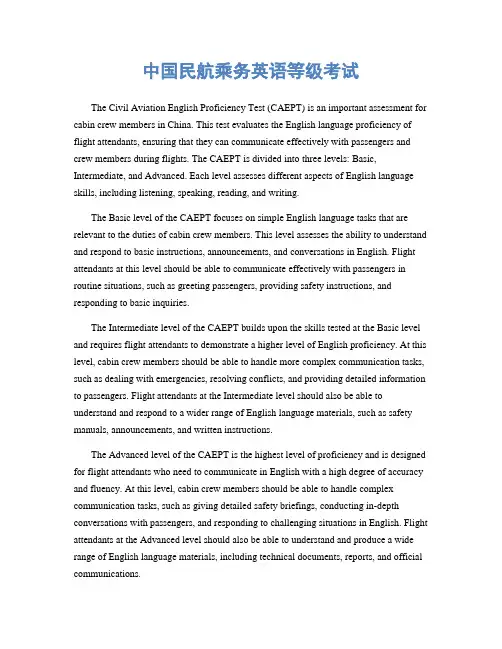
中国民航乘务英语等级考试The Civil Aviation English Proficiency Test (CAEPT) is an important assessment for cabin crew members in China. This test evaluates the English language proficiency of flight attendants, ensuring that they can communicate effectively with passengers and crew members during flights. The CAEPT is divided into three levels: Basic, Intermediate, and Advanced. Each level assesses different aspects of English language skills, including listening, speaking, reading, and writing.The Basic level of the CAEPT focuses on simple English language tasks that are relevant to the duties of cabin crew members. This level assesses the ability to understand and respond to basic instructions, announcements, and conversations in English. Flight attendants at this level should be able to communicate effectively with passengers in routine situations, such as greeting passengers, providing safety instructions, and responding to basic inquiries.The Intermediate level of the CAEPT builds upon the skills tested at the Basic level and requires flight attendants to demonstrate a higher level of English proficiency. At this level, cabin crew members should be able to handle more complex communication tasks, such as dealing with emergencies, resolving conflicts, and providing detailed information to passengers. Flight attendants at the Intermediate level should also be able to understand and respond to a wider range of English language materials, such as safety manuals, announcements, and written instructions.The Advanced level of the CAEPT is the highest level of proficiency and is designed for flight attendants who need to communicate in English with a high degree of accuracy and fluency. At this level, cabin crew members should be able to handle complex communication tasks, such as giving detailed safety briefings, conducting in-depth conversations with passengers, and responding to challenging situations in English. Flight attendants at the Advanced level should also be able to understand and produce a wide range of English language materials, including technical documents, reports, and official communications.In order to pass the CAEPT at any level, flight attendants must demonstrate proficiency in all four language skills: listening, speaking, reading, and writing. They must be able to understand and respond to spoken English, communicate effectively in English, read and comprehend English language materials, and write clear and coherent English texts. Flight attendants who pass the CAEPT at the Basic, Intermediate, or Advanced level will receive a certificate of proficiency, which is valid for two years.Overall, the CAEPT is an essential assessment for cabin crew members in China, as it ensures that flight attendants have the necessary English language skills to perform their duties effectively and communicate with passengers and crew members during flights. By successfully completing the CAEPT at the Basic, Intermediate, or Advanced level, flight attendants can demonstrate their proficiency in English and enhance the safety and efficiency of air travel.。
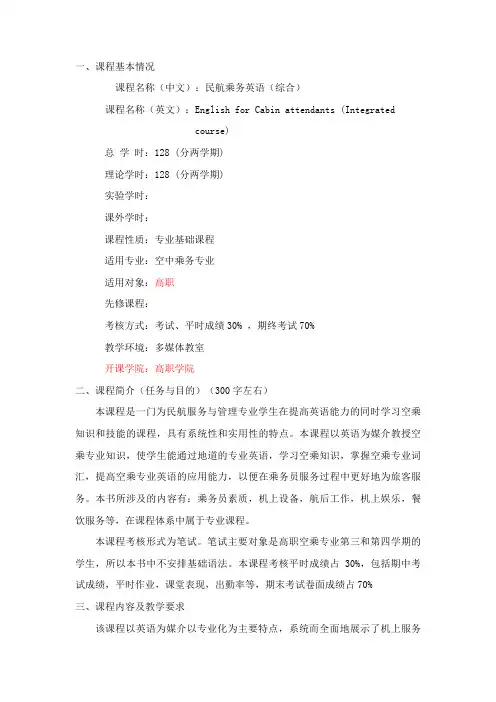
一、课程基本情况课程名称(中文):民航乘务英语(综合)课程名称(英文):English for Cabin attendants (Integratedcourse)总学时:128 (分两学期)理论学时:128 (分两学期)实验学时:课外学时:课程性质:专业基础课程适用专业:空中乘务专业适用对象:高职先修课程:考核方式:考试、平时成绩30% ,期终考试70%教学环境:多媒体教室开课学院:高职学院二、课程简介(任务与目的)(300字左右)本课程是一门为民航服务与管理专业学生在提高英语能力的同时学习空乘知识和技能的课程,具有系统性和实用性的特点。
本课程以英语为媒介教授空乘专业知识,使学生能通过地道的专业英语,学习空乘知识,掌握空乘专业词汇,提高空乘专业英语的应用能力,以便在乘务员服务过程中更好地为旅客服务。
本书所涉及的内容有:乘务员素质,机上设备,航后工作,机上娱乐,餐饮服务等,在课程体系中属于专业课程。
本课程考核形式为笔试。
笔试主要对象是高职空乘专业第三和第四学期的学生,所以本书中不安排基础语法。
本课程考核平时成绩占30%,包括期中考试成绩,平时作业,课堂表现,出勤率等,期末考试卷面成绩占70%三、课程内容及教学要求该课程以英语为媒介以专业化为主要特点,系统而全面地展示了机上服务流程的各主要环节(包括乘务员素质,机上设备,航前准备,航后工作,餐饮服务等)中所需要的专业知识及常见的场景处理方式。
使学生能够通过地道的专业英语,学习空乘专业知识,了解空中服务中应具备的服务常识,掌握空乘专业词汇,提高空乘专业英语的应用能力。
通过学习本书,要求空乘专业的学生达到空乘服务所应有的,既细致又专业的英语服务水准。
本教材内容详实,所涉及内容有:乘务员素质,机上设备,航前准备,航后工作,机上娱乐,餐饮服务,危险品的处置,海关检疫,机场设施,紧急情况下如何控制乘客等每个单元还包括:1. 空乘专业术语:该单元主题的主要专业术语2. 主题文章:系统展示空乘服务所需要的专业知识,专业技能和相关的英语语言知识3. 本单元生词:方便学生阅读和理解4. 注释:对本单元的相关内容进行解释和补充5. 单元练习:强化主要民航知识点和英语语言实际应用能力的锻炼;加深对民航实际服务场景的理解和掌握四、教学课时安排《新世纪民航乘务英语中级综合教程》杨爱荣主编南开大学出版社 2003《新世纪民航乘务英语中级综合教程学习指南》杨爱荣天津教育出版社 2005六、撰写人朱海宁七、审核人朱海宁八、学院(部)审核(盖章)。

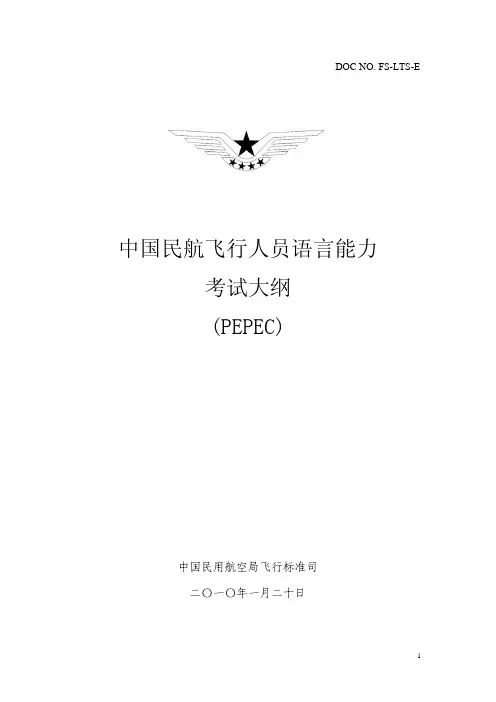
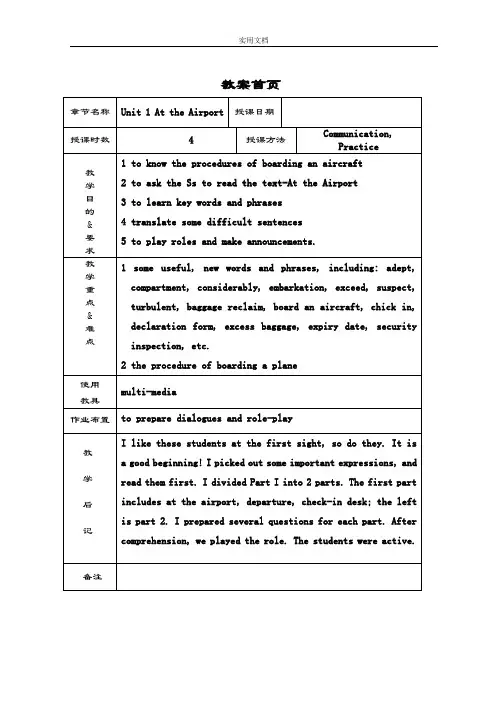
教案首页Period 1-2Ⅰ Self-introduction:ⅡImportance and Definition of Cabin EnglishCompared with the train and bus, plane is the fastest and safest way of transportation. Approximately 3 million passengers are carried on commercial aircrafts every day and delivered safely to their final destination, so it is very important for us to get some knowledge of Cabin English. It includes what passengers should do at the airport; who are airline personnel(航空工作人员);what CA’s should do before, in and after flight; how to deal with some difficult situations, etc.Ⅲ Lead–in 10’1 Ask the students to answer my questions: “Did you travel by air? Can you describe the experience?”2 I’ll introduce my experiences when I travelled by air twice.Ten years ago I travelled to Guizhou province with my friends. Because the train would last two days, we couldn’t bear it, so we chose to go there by air. Because it was the first time for me to travel by air, I was much interested in the flight, and everything was new to me. When the plane took off, I felt weight loss /weightlessness. Everything on the ground became smaller and dimmer gradually; at last what we could see was clouds. Clouds were flying in the sky like angels /fairies. How free they were! How clean they were! The food in the plane was delicious; the air stewardesses were rather pretty. Everything was perfect. Suddenly I felt dumpy, “What happened? Is there anything wrong with our aircraft? Will our plane crash?” I was frightened very much. After a while I was told that that was a little turbulence. Wow, only a false alarm! I released. After 45- minutes- flight, we arrived at Guiyang airport safely. That’s my first experience by air. It’s unforgettable! During this Winter Holiday, I travelled to Hainan province by air. We arrivedand left there at midnight, so I saw nothing but some flashing lights on the wings.Those were my two experiences by air. I believe you will have your own experiences in the future.General Ideas about Unit 1:Ⅳ Aims:1 to get some procedures of how to check in, how to pass through the security control, how to board an aircraft, etc.(了解如何办理登机手续、通过安全检查、登机等流程);2、to learn the key words and expressions.Ⅴ Teaching’s important points and difficulties(教学重点与难点):1 some key words and expressions:adept, approximately, overhead compartment, considerably, destination, detect,embarkation, emit, exceed,exile, expire, expiry date,practice, portable, quarantine,reject, suspect, turbulent,valid, air stairs, aisle seat,baggage allowance, baggage reclaim, baggage tag,conveyor belt, hand luggage, excess baggage,boarding bridge, boarding car /pass, boarding gate,Bureau de Change, business class, economic class,check in, customs control, passport control, declaration form, immigration form, departure lounge,duty-free allowance, go through customs, flight number,ground crew, health certificate, the certificate ofinoculation,terminal building, traveller’s cheque, etc.;2 to get some ideas of how to check in, how to pass through the security control, how to board the plane, etc. and more importantly, you can demonstrate the procedures by yourselves.(更重要的是能将从办理登机手续到登机的工作流程表演出来。
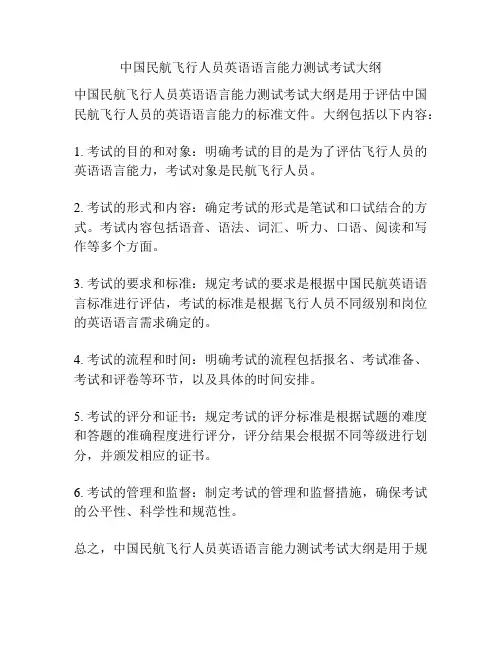
中国民航飞行人员英语语言能力测试考试大纲
中国民航飞行人员英语语言能力测试考试大纲是用于评估中国民航飞行人员的英语语言能力的标准文件。
大纲包括以下内容:
1. 考试的目的和对象:明确考试的目的是为了评估飞行人员的英语语言能力,考试对象是民航飞行人员。
2. 考试的形式和内容:确定考试的形式是笔试和口试结合的方式。
考试内容包括语音、语法、词汇、听力、口语、阅读和写作等多个方面。
3. 考试的要求和标准:规定考试的要求是根据中国民航英语语言标准进行评估,考试的标准是根据飞行人员不同级别和岗位的英语语言需求确定的。
4. 考试的流程和时间:明确考试的流程包括报名、考试准备、考试和评卷等环节,以及具体的时间安排。
5. 考试的评分和证书:规定考试的评分标准是根据试题的难度和答题的准确程度进行评分,评分结果会根据不同等级进行划分,并颁发相应的证书。
6. 考试的管理和监督:制定考试的管理和监督措施,确保考试的公平性、科学性和规范性。
总之,中国民航飞行人员英语语言能力测试考试大纲是用于规
范中国民航飞行人员英语语言能力测试的文件,确保飞行人员具备足够的英语语言能力来应对国际航班和紧急情况。
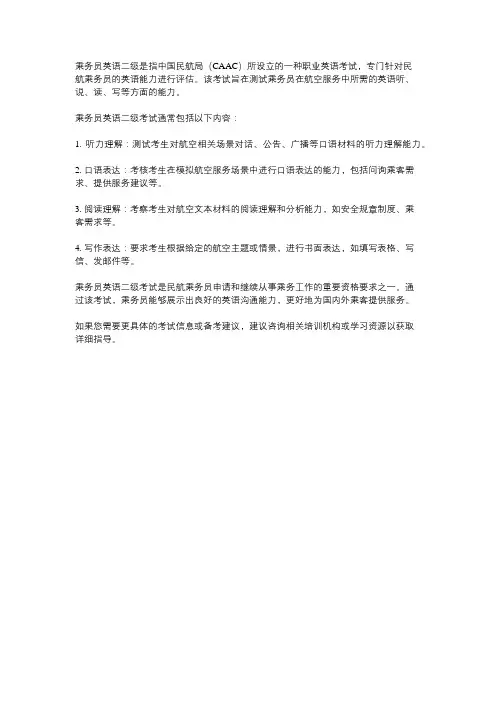
乘务员英语二级是指中国民航局(CAAC)所设立的一种职业英语考试,专门针对民
航乘务员的英语能力进行评估。
该考试旨在测试乘务员在航空服务中所需的英语听、说、读、写等方面的能力。
乘务员英语二级考试通常包括以下内容:
1. 听力理解:测试考生对航空相关场景对话、公告、广播等口语材料的听力理解能力。
2. 口语表达:考核考生在模拟航空服务场景中进行口语表达的能力,包括问询乘客需求、提供服务建议等。
3. 阅读理解:考察考生对航空文本材料的阅读理解和分析能力,如安全规章制度、乘
客需求等。
4. 写作表达:要求考生根据给定的航空主题或情景,进行书面表达,如填写表格、写信、发邮件等。
乘务员英语二级考试是民航乘务员申请和继续从事乘务工作的重要资格要求之一。
通
过该考试,乘务员能够展示出良好的英语沟通能力,更好地为国内外乘客提供服务。
如果您需要更具体的考试信息或备考建议,建议咨询相关培训机构或学习资源以获取
详细指导。

民航乘务英语考试大纲中国民航英语工程乘务英语考试大纲(试行)中国民航总局2001年10月第一章考试总则第一节考试性质民航乘务专业英语考试是由中国民用航空总局组织, 对民航系统内乘务人员的正规英语水平考试.第二节考试目的民航乘务人员的英语水平直接影响着中国民航的服务质量, 影响着中国民航的对外形象, 民航乘务专业英语考试的目的是用考试的方法促进民航乘务人员英语水平的提高, 也为各航空公司安排乘务工作时提供考察乘务人员英语水平的参考依据.第三节考试对象民航乘务专业英语考试的对象是中国民航系统内的在职乘务人员以及高校乘务专业的毕业学生.第四节考试内容民航乘务专业英语考试的内容涉及乘务员素质、机上设施、航前航后准备、机上娱乐、餐饮服务、危险品处置、客舱服务、紧急情况处理、机场设施、海关、检疫等方面的知识。
语言范围主要是基础知识. 内容如下:1.各级考生需掌握的相关的阅读和听说的词汇量. 分别为:初级------2000/1500中级------3500/25002.语音语调基本正确。
3.词法:某些词的词形变化、各类词的作用和构成.4.句法:简单句、并列句、复合句及各种从句。
5.动词:动词的基本时态、非谓语动词(不定式、动名词、现在分词、过去分词)的形式及其作用。
6.形容词和副词的三种级别的用法。
7.虚拟语气。
第五节考试重点一.理解能力1.能正确理解原文, 掌握所读材料的主旨和大意.2.根据所读材料进行一定的判断, 推理和引申.3.既理解个别句子的意义, 又理解上下文之间的逻辑关系.4.领会作者的观点和态度.5.能根据原文正确做出各种练习.二.运用能力1.能正确运用自己的基础知识完成各类试题.2.能听懂考试要求内容并能正确表达自己的观点.第六节考试等级民航乘务专业英语考试根据考试重点和难度设两个等级: 初级和中级.第七节考试形式民航乘务专业英语考试的两个等级均设笔试, 听力, 口试三种形式. 各级的具体考试形式如下:一. 笔试(100分)初级考试:100分1. 词汇句法题量20句. (20%)2.阅读理解题量4段20题. (40%)3.完形填空题量10个空(20%)4.英译汉题量8句(20%)中级考试:100分1. 词汇句法题量20句. (20%)2.阅读理解题量4段20题. (40%)3.完形填空题量10个空(20%)4.英译汉题量8句(20%)二.听力与口语(100分)I.听力初级考试:60分1.辨音数字题量10个音标.(10%)2.单句选择题量10句. (10%)3.简单对话题量10段. (20%)4.短文题量2篇10题(20%)中级考试:60分1.数字题量10个. (10%)2.单句选择题量10个. (10%)3.简单对话题量10个. (20%)4.简单文章题量2段10题(20%)II.口语初级考试:40分1.自我介绍(5分)2.广播词朗读题量1段(15分)2.简单对话题量10题(20分)中级考试:40分1.自我介绍(5分)2. 按要求编播广播词题量1段. (15分)3.回答问题题量8个(20分)第八节考试用时一.笔试初, 中级两个级别笔试的规定时间均为90分钟. 二.听力初级听力考试的规定时间为30分钟.中级听力考试的规定时间为30分钟.三.口试初级口试的规定时间为20分钟.中级口试的规定时间为20分钟.第九节考试方法初、中级的笔试均为书面答题. 所在答案必须写在答题纸上.听力为听录音并书面答题, 均需将答案写在答题纸上.口试均采用人机对话的方式进行.第十节阅卷每次考试结束后,由总局人教司或人教司委派某管理局科教部门监督阅卷。
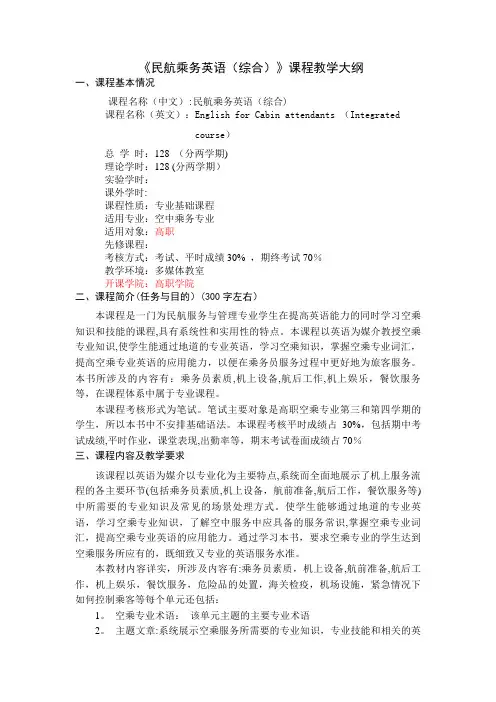
《民航乘务英语(综合)》课程教学大纲一、课程基本情况课程名称(中文):民航乘务英语(综合)课程名称(英文):English for Cabin attendants (Integratedcourse)总学时:128 (分两学期)理论学时:128 (分两学期)实验学时:课外学时:课程性质:专业基础课程适用专业:空中乘务专业适用对象:高职先修课程:考核方式:考试、平时成绩30% ,期终考试70%教学环境:多媒体教室开课学院:高职学院二、课程简介(任务与目的)(300字左右)本课程是一门为民航服务与管理专业学生在提高英语能力的同时学习空乘知识和技能的课程,具有系统性和实用性的特点。
本课程以英语为媒介教授空乘专业知识,使学生能通过地道的专业英语,学习空乘知识,掌握空乘专业词汇,提高空乘专业英语的应用能力,以便在乘务员服务过程中更好地为旅客服务。
本书所涉及的内容有:乘务员素质,机上设备,航后工作,机上娱乐,餐饮服务等,在课程体系中属于专业课程。
本课程考核形式为笔试。
笔试主要对象是高职空乘专业第三和第四学期的学生,所以本书中不安排基础语法。
本课程考核平时成绩占30%,包括期中考试成绩,平时作业,课堂表现,出勤率等,期末考试卷面成绩占70%三、课程内容及教学要求该课程以英语为媒介以专业化为主要特点,系统而全面地展示了机上服务流程的各主要环节(包括乘务员素质,机上设备,航前准备,航后工作,餐饮服务等)中所需要的专业知识及常见的场景处理方式。
使学生能够通过地道的专业英语,学习空乘专业知识,了解空中服务中应具备的服务常识,掌握空乘专业词汇,提高空乘专业英语的应用能力。
通过学习本书,要求空乘专业的学生达到空乘服务所应有的,既细致又专业的英语服务水准。
本教材内容详实,所涉及内容有:乘务员素质,机上设备,航前准备,航后工作,机上娱乐,餐饮服务,危险品的处置,海关检疫,机场设施,紧急情况下如何控制乘客等每个单元还包括:1。
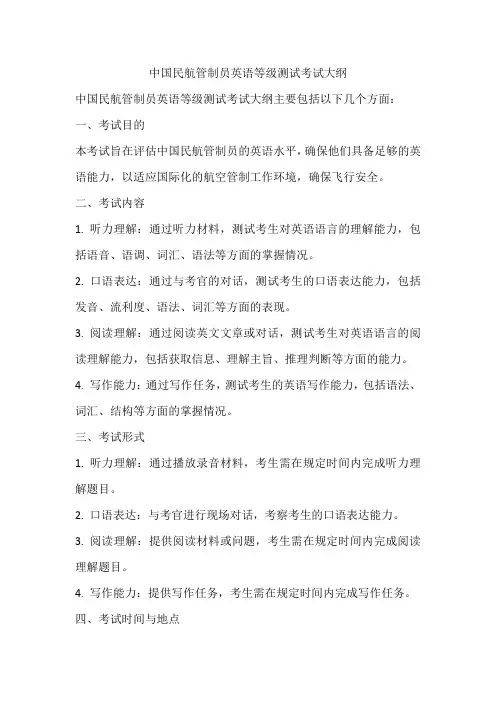
中国民航管制员英语等级测试考试大纲
中国民航管制员英语等级测试考试大纲主要包括以下几个方面:一、考试目的
本考试旨在评估中国民航管制员的英语水平,确保他们具备足够的英语能力,以适应国际化的航空管制工作环境,确保飞行安全。
二、考试内容
1. 听力理解:通过听力材料,测试考生对英语语言的理解能力,包括语音、语调、词汇、语法等方面的掌握情况。
2. 口语表达:通过与考官的对话,测试考生的口语表达能力,包括发音、流利度、语法、词汇等方面的表现。
3. 阅读理解:通过阅读英文文章或对话,测试考生对英语语言的阅读理解能力,包括获取信息、理解主旨、推理判断等方面的能力。
4. 写作能力:通过写作任务,测试考生的英语写作能力,包括语法、词汇、结构等方面的掌握情况。
三、考试形式
1. 听力理解:通过播放录音材料,考生需在规定时间内完成听力理解题目。
2. 口语表达:与考官进行现场对话,考察考生的口语表达能力。
3. 阅读理解:提供阅读材料或问题,考生需在规定时间内完成阅读理解题目。
4. 写作能力:提供写作任务,考生需在规定时间内完成写作任务。
四、考试时间与地点
1. 考试时间:根据实际情况确定。
2. 考试地点:根据实际情况确定。
五、考试成绩与证书
1. 考试成绩:根据考生的答题情况,给出相应的成绩。
2. 证书:根据考生的考试成绩,颁发相应的英语等级证书。
以上是中国民航管制员英语等级测试考试大纲的主要内容。
考生在备考过程中,应注重提高自己的英语听说读写能力,熟悉考试形式和内容,以便更好地应对考试。
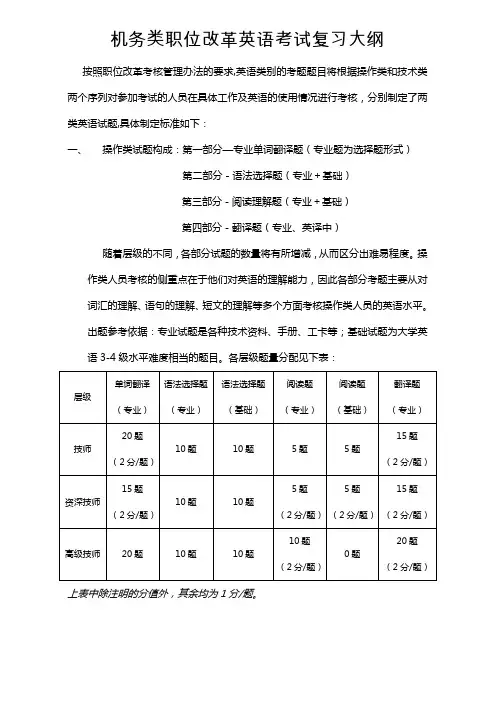
机务类职位改革英语考试复习大纲按照职位改革考核管理办法的要求,英语类别的考题题目将根据操作类和技术类两个序列对参加考试的人员在具体工作及英语的使用情况进行考核,分别制定了两类英语试题,具体制定标准如下:
一、操作类试题构成:第一部分—专业单词翻译题(专业题为选择题形式)
第二部分-语法选择题(专业+基础)
第三部分-阅读理解题(专业+基础)
第四部分-翻译题(专业、英译中)
随着层级的不同,各部分试题的数量将有所增减,从而区分出难易程度。
操作类人员考核的侧重点在于他们对英语的理解能力,因此各部分考题主要从对词汇的理解、语句的理解、短文的理解等多个方面考核操作类人员的英语水平。
出题参考依据:专业试题是各种技术资料、手册、工卡等;基础试题为大学英语3-4级水平难度相当的题目。
各层级题量分配见下表:
上表中除注明的分值外,其余均为1分/题。
二、技术类试题结构:第一部分—听力题(专业+基础)
第二部分-语法选择题(专业+基础)
第三部分-阅读理解题(专业+基础)
第四部分-翻译题(专业、英译中)
随着层级的不同,各部分试题的数量将有所增减,从而区分出难易程度。
技术类人员考核的侧重点在于他们的英语实际运用能力,因此考题除了理解方面的题目外还增加了英语听力题。
出题参考依据:专业试题是各机型的培训语音软件,波音、空客提供的英语培训教材、各种技术资料、手册、工卡等;基础试题为大学英语4-6级水平难度相当的题目。
各层级题量分配见下表:。
《民航专业英语》课程教学大纲一、适用对象本丄纲适用于高职高专三年制空乘英语专业第一学期的学生。
二、课程性质《民航专业英语》是空乘专业的职业基础课,也是职业核心课,为B类课。
本课程与英语语言有密切的关联,如英语听力、口语、阅读、写作等等;同时与空乘行业也有交集。
所以是跨越两学科的一门实用课程。
三、课程目标本课程首要H标是培养和提高学生的英语交际能力和机丄的应变能力。
了解并掌握民航服务英语的基本内容与相关的语言他识及民航地而服务所需的相关英语知识,包括:机型、飞行计划、空管、机场、航空公司、客货运输、机票、行李、安检等内容。
木着这样的宗旨,课堂上将提供让学牛大量进行口语训练的机会,并且让学生熟悉空乘服务屮涉及到的专业知识和服务技巧。
课堂上设计生动逼真的会话情景,以及富有创意的角色扮演,让学生能够进一步巩固和发展他们的语言实际交际能力,为将来他们的空乘工作打下坚实的基础。
四、课程总学时及学分《民航专业英语》课内学吋数为36学吋,共2学分。
五、课程设计本课程在教学过程屮,要充分将理论和实际相结合。
语言只有通过不断练习才可以不断进步,口语尤其如此。
因此课堂上要组织各种各样的活动,创造大量机会让学生进行口语训练,激发他们的兴趣和主动性。
同吋也要将空乘方面的专业英语术语和文化差异融入其屮,使他们在专业素质方面有一个质的提升。
六、教材及媒体使用说明文字教材:高等教育岀版社06年版《民航乘务英语》本教材从培养高级应用型人才的总体H标出发,结合学生毕业后的工作实际,力求向学生提供其未来工作岗位所需要的专业英语知识技能,培养学生使用涉外业务英语的交际能力。
突出选材的真实性、科学性、吋代性、趣味性和多样性,更有利于激发学习兴趣和实现培养n标。
另外可以多多使用相关多媒体资料,以增加教学的生动性与形象性,增加学生兴趣,提高教学效果。
七、课程内容Unit 1 At the airport教学重点:1•阅读部分:机场的结构、登机程序、护照检查、安全检查等等。
专业代码:660108/520503商务英语(航空乘务方向)专业人才培养方案(校企合作专业)适用对象:高中学制:三年学历层次:大专适用年级: 2012 级计划执笔人:闵玉娟制定部门:南京化工职业技术学院经济管理系制定日期:2012 年 5 月2012级商务英语(航空乘务方向)专业/空中乘务(艺术类)专业人才培养方案目录一、培养目标及职业面向 (1)1.培养目标 (1)2.职业面向 (1)二、毕业资格 (1)1.学时学分要求: (1)2.技能证书要求 (1)三、课程设置及课时分配 (2)(一)公共基础课 (2)(二)职业基础课 (3)(三)职业技术方向课 (5)(四)素质拓展模块 (6)(五)实践环节 (7)四、必要说明 (8)附表一综合能力框图 (9)附表二课程体系框图 (10)附表三素质框图 (11)附表四专业课程设置一览表 (11)附表五教学进程表........................................................... 错误!未定义书签。
附表六课外必修、选修项目安排................................... 错误!未定义书签。
一、培养目标及职业面向1.培养目标(一)人才培养规格培养德、智、体、美全面发展的,与我国社会主义市场经济要求相适应的,掌握本专业必备的“听说读写译”等语言基本技能和商务类专门知识,具有从事涉外商务类工作的基本业务水平和较强的实践能力活动,从事涉外会展、文秘、营销的综合职业能力和全面素质,使学生具有运用英语解决商务问题的能力及适当的职业迁移能力,以“外语+专业+技能”为特色,提升学生的就业竞争力,培养生产、商务流通、管理和服务等第一线工作的高等职业技术应用性专门人才。
(二)知识、能力目标1、知识目标1)了解本专业高职应用性专门人才所必需的基础文化知识。
2)熟悉空中乘务(商务英语方向)专业所必须的专业基础知识。
中国民航英语工程乘务英语考试大纲(试行)中国民航总局2001年10月第一章考试总则第一节考试性质民航乘务专业英语考试是由中国民用航空总局组织, 对民航系统乘务人员的正规英语水平考试.第二节考试目的民航乘务人员的英语水平直接影响着中国民航的服务质量, 影响着中国民航的对外形象, 民航乘务专业英语考试的目的是用考试的方法促进民航乘务人员英语水平的提高, 也为各航空公司安排乘务工作时提供考察乘务人员英语水平的参考依据.第三节考试对象民航乘务专业英语考试的对象是中国民航系统的在职乘务人员以及高校乘务专业的毕业学生.第四节考试容民航乘务专业英语考试的容涉及乘务员素质、机上设施、航前航后准备、机上娱乐、餐饮服务、危险品处置、客舱服务、紧急情况处理、机场设施、海关、检疫等方面的知识。
语言围主要是基础知识. 容如下:1.各级考生需掌握的相关的阅读和听说的词汇量. 分别为:初级------2000/1500中级------3500/25002.语音语调基本正确。
3.词法:某些词的词形变化、各类词的作用和构成.4.句法:简单句、并列句、复合句及各种从句。
5.动词:动词的基本时态、非谓语动词(不定式、动名词、现在分词、过去分词)的形式及其作用。
6.形容词和副词的三种级别的用法。
7.虚拟语气。
第五节考试重点一.理解能力1.能正确理解原文, 掌握所读材料的主旨和大意.2.根据所读材料进行一定的判断, 推理和引申.3.既理解个别句子的意义, 又理解上下文之间的逻辑关系.4.领会作者的观点和态度.5.能根据原文正确做出各种练习.二.运用能力1.能正确运用自己的基础知识完成各类试题.2.能听懂考试要求容并能正确表达自己的观点.第六节考试等级民航乘务专业英语考试根据考试重点和难度设两个等级: 初级和中级.第七节考试形式民航乘务专业英语考试的两个等级均设笔试, 听力, 口试三种形式. 各级的具体考试形式如下:一. 笔试(100分)初级考试:100分1. 词汇句法题量20句. (20%)2.阅读理解题量4段20题. (40%)3.完形填空题量10个空(20%)4.英译汉题量8句(20%)中级考试:100分1. 词汇句法题量20句. (20%)2.阅读理解题量4段20题. (40%)3.完形填空题量10个空(20%)4.英译汉题量8句(20%)二.听力与口语(100分)I.听力初级考试:60分1.辨音数字题量10个音标.(10%)2.单句选择题量10句. (10%)3.简单对话题量10段. (20%)4.短文题量2篇10题(20%)中级考试:60分1.数字题量10个. (10%)2.单句选择题量10个. (10%)3.简单对话题量10个. (20%)4.简单文章题量2段10题(20%)II.口语初级考试:40分1.自我介绍(5分)2.广播词朗读题量1段(15分)2.简单对话题量10题(20分)中级考试:40分1.自我介绍(5分)2. 按要求编播广播词题量1段. (15分)3.回答问题题量8个(20分)第八节考试用时一.笔试初, 中级两个级别笔试的规定时间均为90分钟. 二.听力初级听力考试的规定时间为30分钟.中级听力考试的规定时间为30分钟.三.口试初级口试的规定时间为20分钟.中级口试的规定时间为20分钟.第九节考试方法初、中级的笔试均为书面答题. 所在答案必须写在答题纸上.听力为听录音并书面答题, 均需将答案写在答题纸上.口试均采用人机对话的方式进行.第十节阅卷每次考试结束后,由总局人教司或人教司委派某管理局科教部门监督阅卷。
在阅卷监督人员没到场时,主考单位不得将考生试卷袋打开。
第十一节考试记分无论考生参加那一级的考试,均需完成各级的笔试、听说二种形式的考试。
各项考试分分别为100分,即:笔试为100分, 听说为100分.考生要在笔试、听说成绩分别达到60分以上(听说考试中口语成绩不能低于20分)者为合格.第十二节考试结果每次考试结束后,主考单位应及时组织阅卷,并将成绩上报总局,最迟不得超过一个月,如有特殊原因应及时向总局人教司报告。
主考单位无权向考生和考生单位通报考试结果。
凡通过中级考试的考生,由民航总局人教司向其颁发相应的证书,证书有效期为5年.第十三节考试时间考试每年1月和7月各举行一次, 具体时间由民航总局人教司确定.根据各公司的培训和工作情况,需要在总局所规定考试时间以外安排考试的单位,应向总局人教司提出口头或书面申请,经总局人教司批准后,通知主考单位安排落实。
第十四考试地点各级考试的考场均设在中国民航学院(), 在考生较集中的单位,可由单位向主考单位申请设立分考场.第十五节考试命题各级考试题均由计算机随机命题. 在民航总局人教司的负责人员监督下, 开机提取, 编辑加工, 封闭印刷, 装订成册后全部密封备用.第十六节题库各级题库均以计算机软盘方式保存, 由民航总局人教司指定专人保存, 任何人不得复制.ENGLISH PROFICIENCY TESTFOR FLIGHT ATTENDANTS(LISTENING TEST)PART 1 Number IdentificationDIRECTIONS: In this part, you will hear 10 sentences. Each sentence contains one of the four numerical phrases marked A, B, C, and D given to you. Listen carefully and choose the right phrase, then mark it on your ANSWER SHEET.1. A.9418 C. 1948B. 9148 D. 91842. A.$49.99 B. $49.89C. $39.99D. $39.893. A. 8:25 C. 8:55B. 8:35 D. 8:454. A. 1726 B. 2762C. 1762D. 70625. A. 8 C. 800B. 80 D. 186. A. 001-232-5220 B. 010-232-5202C. 010-223-5202D. 001-223-52027. A.35-38 B. 34-39C. 35-39D. 34-388. A. 147,361,000 B. 14,736,100C. 1,473,610D. 147,3619. A. Sept. 13th…6th B. Sept.13th… 16thC. Oct. 13th… 6thD. Oct. 13th…16th10. A. CPG332T B. CPG323CC. CPG323TD. CPG332CPART 2 StatementsDIRECTIONS: In this part, you will hear 10 statements. To each statement, there are 4 choices printed on your test paper marked A, B, C, and D, only one of which, however, is closest in meaning to the sentence you've heard. Listen carefully, choose the one you think correct, and mark it on your ANSWER SHEET.EXAMPLE:You will hear: The flight leaves at 5:15 p.m.You will read: A. It leaves in the morning.B. It leaves in the afternoon.C. It leaves at 4 o'clock in the morning.D. It leaves at night.Sentence B. "It leaves in the afternoon." is closest in meaning to statement "The flight leaves at 5:15 p.m." Therefore, you should choose answer B, and mark it on your ANSWER SHEET.11. A. You enjoyed the lecture too, didn't you?B. I don't care for her lectures, do you?C. Her lecture was on a serious topic.D. She enjoys giving lectures.12. A. I don't want to see Jeff.B. At last Jeff wants to see me.C. Jeff was the last person to see me.D. I want to see Jeff least13. A. The passengers are satisfied with the service.B. The passengers are not satisfied with the service.C. The cabin attendants are very helpful on this flight.D. The passengers are very grateful to the cabin attendants on the flight .14. A. She is leaving by car.B. She is leaving by train.C. She is leaving by sea.D. She is leaving by plane.15. A. He lives in a warm climate.B. He doesn't live in a warm climate.C. He lived in a warm climate.D. He lives in a hot climate.16. A. The Martins visited us.B. We visited the Martins.C. The Martins were very busy.D. We didn't have time to visit the Martins.17. A. About a half hour before departure, the passengers begin boarding.B. About an hour before departure, the passengers begin boarding.C. Around an hour before departure, the passengers begin checking-in.D. Around a half hour before departure, the passengers begin check-in.18. A. Jane is feeling a sharp pain in her eyes.B. Jane has got a sharp ache in her legs.C. Jane has got a slight pain in her head.D. Jane has got a slight ache in her legs.19. A. The toilets are very clean.B. The toilets are very dirty.C. The toilets are occupied.D. The toilets are empty.20. A. You have a more selection of drinks on a plane.B. You have a good selection of drinks on a plane.C. You have a less selection of drinks at a bar.D. You have a good selection of drinks at a bar on the ground.PART 3 ConversationsDIRECTIONS: In this part, you will hear 10 short conversations. At the end of each conversation, a question will be asked about it. To the question you've heard, there are four possible answers printed on your test paper and marked with A, B, C, and D. Listen carefully, choose the best answer, and mark it on your ANSWER SHEET.EXAMPLE:You will hear: M: Excuse me, Miss. Would you please show me where my seat is?W: Your boarding pass, please. Your seat number is 15A, on the left side of the aisle. This way, please.Q: Where does this conversation most probably take place?You will read: A: In a restaurant. B. In a theater.C: On an airplane. D. In a waiting-room.From the conversation we know this talk is between a stewardess and a passenger, which is most likely to have taken place on an airplane. Therefore, "C. on an airplane" is the best answer. You should choose answer "C", and mark it on your ANSWER SHEET.21. A. Well-mannered. C. Good-looking.B. Good-humored. D. Intelligent.22. A. He likes bananas. C. He can only afford bananas.B. He wants nothing but bananas. D. He wants to lose some weight.23. A. A new suit. C. A new skirt.B. A new shirt. D. A pair of new shoes.24. A. Mrs. Smith's. C. Mrs. Morgan's.B. Mr. Smith's. D. Mr. Morgan's.25. A. He has only seen a Boeing 747 on TV.B. There is a TV set on the Boeing 747.C. He only watches TV.D. He likes watching TV on a Boeing 747.26. A. French dressing. C. Fresh dressing.B. Thousand Island dressing. D. Salad dressing.27. A. He isn't sure, but he'll try his best.B. He is sure to get there on time.C. He promises to get there on time.D. He can be there on time.28. A. The captain can't come.B. She hopes the captain won't comeC.. She thinks the captain will be on time.D. The captain will be late.29. A. If the cocktail service is very close to meal service.B. When drinks are served.C. When the cabin attendants are busy.D. When the meal service is served.30. A. Pick up the chair. C. Remain standing.B. Sit down at once. D. Leave in a minute.PART 4 PassagesDIRECTIONS: In this part, you will hear 2 passages, each followed by 5 questions. To each question, there are 4 possible answers marked with A, B, C, and D. You are to choose the correct one and mark it on your ANSWER SHEET.Questions 31 to 35 are based on the following passage:31. A. At 11:00 B. At 1:00C. At 11:25D. At 2:0032. A. At 1:00 B. At 11:00C. At 11:35D. At 11:2533. A. It's just behind the international terminal.B. It's just beside the international terminal.C. It's just in the front of the international terminal.D. It's just on the opposite of the international terminal.34. A. When does he have to reconfirm his reservation before he returns?B. Where does he reconfirm his reservation?C. How does he reconfirm his reservation?D. Who will help him to reconfirm his reservation before he returns?35. A. He should do it 72 hours before.B. He should check with the information counter in the arrival lobby.C. He should ask for the ground attendants.D. He should do it 3 days before.Questions 36 to 40 are based on the following passage:36. A. Because a modern airline pilot has to follow set routes and keep to a rigid schedule.B. Because flying is not as much fun as it used to be.C. Because everything a pilot does is governed by instruments.D. Because a pilot has to obey regulations.37. A. He has the responsibilities to obey the rules.B. He is responsible for all the instruments on board.C.. He is responsible for the aeroplane and the passengers.D. He has the responsibilities to look after all the crew members38. A. Because the aeroplane was smaller.B. Because the pilot was more able.C. Because a pilot had more experience.D. Because a pilot was free to go where he liked, when he liked.39. A. He could follow a railway line.B. He could land in a convenient field to ask the way.C. He could rely on his own experienceD.. Both (A) and (B)40. A. They spend much of their spare time reading about old aircraft or even rebuilding andflying them.B. They spend a lot of time talking about the good old days.C. They buy models of old aeroplanes.D. They like flying old aeroplanes.ENGLISH PROFICIENCY TEST FOR FLIGHT ATTENDANTS(ORAL TEST)PART 1 Self-IntroductionDIRECTIONS: In this part, within 2 minutes, you are required to make self-introduction about your occupation, your family, your hobbies and so forth.PART 2 AnnouncementsDIRECTIONS: In this part, you are required to make announcements according to the given clue within 2 minutes. Read it aloud in a professional way.The plane is delayed, because connecting passengers haven’t boarded the plane. Inform the passengers on board.PART 3 Free TalkDIRECTIONS: In this part, you are required to answer 8 questions you’ve heard on the tape.ENGLISH PROFICIENCY TESTFOR FLIGHT ATTENDANTS(WRITTEN TEST)PART 1 Vocabulary & StructureDIRECTIONS: In this part, there are 20 incomplete sentences. Each of them is followed by four possible choices marked with A, B, C, and D. You are required to choose the correct or best one to complete each sentence. Mark it on your ANSWER SHEET.1. The physical examinations are required ______ for all flight service personnel.A. at timesB. in the event of an emergencyC. once in a life timeD. periodically2. Of all the duties that the stewardess performs on board, the one that occupies the greatestamount of her time is ______.A. helping passengers locate their seatsB. serving food and drinks to the passengersC. explaining the use of the passenger service unitD. making life jacket and oxygen mask demonstrations3. ______ of your safety, please fasten your seat belt.A. The sakeB. For the sakeC. With the sakeD. To the sake4. Often the cabin attendants report ______ , which means that the equipment is not workingproperly to the flight engineer.A. faulty equipmentB. service mistakeC. galley procedureD. purser's log5. I'm sorry but I must ask you to stop smoking because ______.A. it is safeB. for the sake of safetyC. of safety is concernedD. it is a matter of safety6. The plane is ______ when it is taken over by people with weapons, such as guns, knives,explosives, ect.A. on fireB. hijackedC. diverted to an alternateD. sprayed against insects7. Sometimes if none of the stewardesses can speak a passenger's language , it is possible______.A. not to serve him at allB. to communicate with him by writingC. to get help from another passengerD. not to keep him informed8. It is ______ to use the walkman during the flight according to the CAAC regulations.A. allowedB. prohibitedC. requiredD. expected9. Can I offer you ______, sir?A. to read somethingB. something to readC. to read anythingD. anything reading10. Jet stream can increase the speed of the plane flying ______.A. north to southB. south to northC. west to eastD. east to west11. My friend did not know _______ or not he passed the exam.A. whetherB. ifC. whyD. when12. Public television stations are different from commercial stations _______ .A. because they receive money differently and different types of showB. for money and program typesC. in the areas of funding and programmingD. because the former receives money and has programs differently from the latter13. She is ______ age ______ her workmate.A. same...asB. same...ofC. the same...ofD. the same...as14. My goodness, look at the time! It's nine o'clock ______ and I'm ______ at breakfast.A. already...yetB. yet... stillC. still...alreadyD. already...still15. Jane, as well as Alice and Martha, ______ nursing at the Queen College.A. is studyingB. are studyingC. were studyingD. has been study16. She wanted to serve some coffee to her guests; however,________ .A. she hadn't many sugarB. there was not a great amount of the sugarC. she did not have much sugarD. she was lacking in amount of the sugar17. The movie that we saw last week was quite interesting, ________A. wasn't it?B. was it?C. didn't it?D. weren't we?18. Tom said that no other car could go _______.A. so far like his car C. as fast like the car of himB. as fast like his car D. as fast as his car19. Can you see that man ______ a blue coat ______ a pair of glasses ______ his face?A. with ... with...inB. in...with...onC. in...on...onD. in...in...on20. His ideas were far ______ the age in which he lived.A. in front ofB. in advanceC. at an advantageD. in adventure ofPART 2 Reading ComprehensionDIRECTIONS: In this part, there are 3 passages. Each of them is followed by 5 questions, and to each question, there are four possible answers marked with A, B, C, and D. Please choose the correct or best answer to each question and mark it on your ANSWER SHEET.Questions 21 to 25 are based on the following passage:Ever since humans have inhabited the earth, they have made use of various forms of communication. Generally, this expression of thoughts and feeling has been in the form of oral speech. When there is a language barriers communication is accomplished through sign language in which motions stand for letters, words, and ideas. Tourists, the deaf, and the mute have had to resort to this form of expression, many of these symbols of whole word are very picturesque and exact and can be used internationally; spelling, however, cannot.Body language transmits ideas or thoughts by certain actions, either intentionally or unintentionally. A wink can be a way of flirting or indicating that the part is only joking. A nod signifies approval, while shaking the head indicates a negative reaction.Other forms of nonlinguistic language can be found in Braille(a system of raised dots read with the fingertips), signal flags, Morse code, and smoke signals. Road maps and picture signs also guide, warn, and instruct people.While verbalization is the most common form of language, other system and techniques also express human thoughts and feelings.21. Which of the following best summarizes this passage?A. Although other forms of communication exist, verbalization is the fastest.B. Everybody uses only one form of communication.C. Nonlinguistic language is invaluable to foreigners.D. When language is a barrier, people will find other forms of communication.22. Which of the following statements is not true?A. The deaf and mute use an oral form of communication.B. Verbalization is the most common form of communication.C. There are many forms of communication in existence today.D. Ideas and thoughts can be transmitted by body language.23. Which form other than oral speech would be most commonly used among blind people?A.. Braille. C. Body language.B. Picture signs D. Signal flags.24. How many different forms of language are mentioned here?A. 9 C. 5B. 7 D. 1125. Sign language is said to be very picturesque and exact and can be used internationally exceptfor ______.A. expression C. whole wordsB. ideas D. spellingQuestions 26 to 30 are based on the following passage:Hotels for MotoristsThe first hotels were very different from today's hotels. They were small inns built along the road. Later, as people began to travel by train, hotels were built in the centers of large cities. Usually near rail-road stations, these hotels were many stories tall and had hundreds of rooms.Although trains were a popular means of travel for some time, automobiles slowly began to take their place. Automobile travel caused problems for city hotels, which did not have parking space for so many cars.People who traveled by automobile needed a different kind of hotel. They needed places to stay that were near highways and had room to park. Motorists did not like to drive in heavy city traffic to reach a hotel. The answer to the motorists' problems came when a new kind of hotel was built. These new buildings were called motels, a word made from the first part of MOTORIST and the last part of HOTEL.Motels were much smaller than hotels. Built on ground level, often in separate units, they were more convenient for people traveling. The separate units also made them quieter than hotels. Best of all, there was more than enough room for cars to park.Now, many big hotels in the cities are being torn down. They can no longer make enough money to stay in business. In their place, many small motels have been built on the outskirts of cities. Motels have become a big business in the United States.26. The first hotels were built ______.A. with hundreds of rooms.B. around the city centers.C. not far away from roads.D. near railway stations.27. Hotels became less popular because they usually did not have _______.A. a place for cars to park inB. large enough rooms for big families.C. sufficient ground rooms.D. quiet and convenient units.28. Motels are usually _______.A. large, high buildings built in the downtown area.B. small, low buildings built along highways outside the city.C. small, high buildings built on the outskirts.D. large, low buildings built around city center.29. The reason why many big hotels are being torn down is that _______.A. it costs too much money to stay in a hotel.B. people need the materials to build small motels.C. they are losing their competition to motels.D. cities are usually short of land for building motels.30. On the whole, this passage is about ______.A.. the reason why a new kind of hotel came into being.B. motorists' problems out on the highwayC. which place is better for people to stay for the night.D. how to find a place to park your car during travel.Questions 31 to 35 are based on the following passage:The flight service crew members should always deal with the passengers and with each other in a professional and dignified manner. It is necessary to avoid excessive familarity with passengers. The cabin crew must also pay careful attention to their personal appearance during the flight. The airlines consider good grooming to be representative of the flight attendants' good will and personal pride.When the cabin crew is making its periodic checks, the passengers will often have questions about service, schedules, routes, and weather. The cabin attendants try to answer these questions pleasantly, and they should avoid airline jargon with which the passengers may not be familiar. In addition to making the regular cabin checks, the attendants should answer call buttons promptly and courteously.The cabin attendants are also responsible for the neatness and cleanliness of the passenger cabins. They keep the cabin, the lavatories, and the galleys clean at all times and clear of briefcases, purses, galley equipment, and so on. Cabin attendants report any item of equipment that is not working properly to the flight engineer.31. How should the flight service crew deal with the passengers and with each other?A. In a professional and dignified manner.B. In a dignified manner.C. In a good manner.D. In a professional manner.32. Why do the cabin crew pay careful attention to their grooming during the flight?A. Because every airline requires the flight attendants do so.B. Because it represents the flight attendants' good will and personal pride.C. Because passengers like it.D. Because the flight attendant likes to do so.33. How do the cabin attendants answer the passengers questions?A. Promptly. C. Quickly.B. Courteously. D. Pleasantly.34. What must be kept neat and clear of briefcases ?A. All the above. C. Lavatories.B. Galleys. D. Cabin.35. Which of the following statements is not true?A. The cabin attendants report any item of equipment which is not working properly to thepilot.B. The cabin attendants should answer call buttons promptly and courteously.C. The cabin attendants are responsible for the cleanliness of the galleys.D. The cabin attendants should avoid airline jargon when they answer passengers' questions.Questions 36 to 40 are based on the following passage:There are standards of grooming for each airline, and they are clearly stated. There are differences from one company to another, but the general rules apply to most, since this is a major grooming concern. The important thing is that there should be an attractive, simple style reflecting current fashion. Extremes are to be avoided, as are styles that would interfere with proper wearing of the hat. The style must be maintained; if a stewardess does not have the time to do this properly, she must choose a more manageable style.Hair length is a matter of individual preference. The length should look well with the uniform, and it should suit the wearer. The hair may not be worn long and loose. It should not fall forward on to the face while serving meals and drinks. If hair is long enough to be tied back, it must be worn in a George Washington, a chignon, or some other contemporary style.36. If a stewardess does not have time to maintain her hair,_____________ .A. she must choose a more manageable styleB. it must be worn in a George WashingtonC. it must be fastenedD. it should suit the wearer37. The passage tells us something about _________ .A. how to become a stewardessB. groomingC. hat wearingD. general rules for stewardess38. What are the general guidelines for hairstyle?A. An attractive, simple style reflecting current fashion.B. Fashionable and extreme style.C. Old style.D. Short hair style.39. According to the passage which of the following statements is not true?A. Hair style is a matter of individual matter.B. Different airline has different guidelines for hair style.C. Hair may not be worn long and loose.D. If hair is long enough, it must be tied up.40. Why shouldn't hair be worn loose and long?A. Because it doesn't look fine.B. Because it is hard to control.C. Because it would interfere with serving meals and drinks.D. Because it would take much time to manage.PART 3 Cloze TestDIRECTIONS: In this part, the words and phrases are missing in the following paragraph. Choose the most appropriate from the words and phrases marked with A, B, C, and D, and mark it on your ANSWER SHEET.The price of hotels in Britain is going up 41 at any time since the war. There are a number of reasons for this but the 42 all is the Government’s economic policy. Managers in factories see 43 so they are attracted to the idea of owning 44 businesses. 45 Britain’s weather is often disappointing, the tourist industry is growing. Many people 46 like to combine a 47 holiday with the opportunity of improving their English. It is therefore not surprising that businessmen are buying hotels. The only thing 48 worries me is the kind of treatment their guests are 49 to receive since 50 of them know anything about hotel management.41. A. more fast than B. more fast than C. faster than D. more faster than42. A. most important of B. more important ofC. most important fromD. more important from43. A. to fall their standard of living B. falling their standard of livingC. their standard of living to fallD. their standard of living falling44. A. his proper B. his own C. their proper D. their own45. A. In spite of B. Although C. Even D. However46. A. in the Continent B. in the overseas C. abroad D. foreign47. A. fortnight B. fortnight’s C. two weeks D. two week’s48. A. that B. what C. as D. who49. A. like B. probable C. probably D. likely50. A. little B. a little C. few D. a fewPART 4 TranslationDIRECTIONS: In this part, there are seven sentences written in English. Translate these sentences into Chinese.51. Each airline flies specific routes, and each stewardess must be familiar with the routes and withthe cities that are served by the airline she represents.52. The way stewardesses dress and look may often determine whether a customer will choose tofly on that airline again.53. The flight service crew members should always deal with the passengers and with each other ina professional and dignified manner.54. New technological developments in recent years have simplified the operation, and now themechanical aspects of the film-showings are relatively simple and trouble-free.55. Each crew member, whether he or she works in the galley, the cabin, or the cockpit, has certainduties to perform, and these must be coordinated with those of the rest of the crew.56.I’ll give you whatever support I can within my ability.57.There is no denying the fact that the new management method has greatly increased theproduction.58.All living languages are characterized by sound changes that have occurred and will continue tooccur in the course of their history。